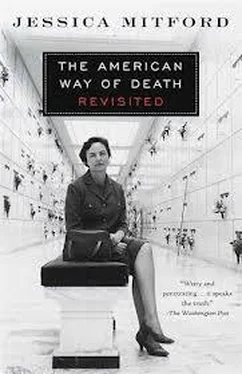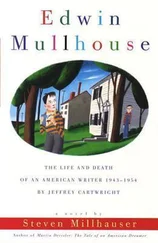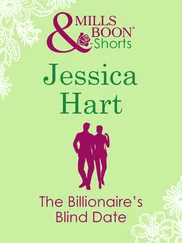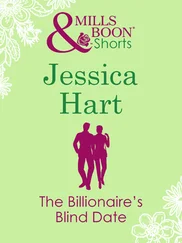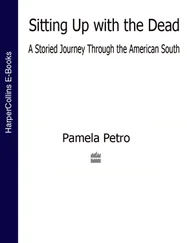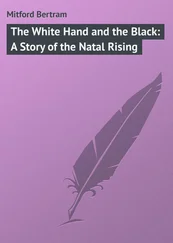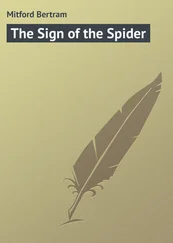The Comprehensive Sales Program Successful Mortuary Operation is designed along the same lines as Mr. Krieger’s plan, only it is even more complicated. Everything is, however, most carefully spelled out, beginning with the injunction to greet the clients with a warm and friendly handshake and a suggested opening statement, which should be “spoken slowly and with real sincerity: ‘I want to assure you that I’m going to do everything I can to be helpful to you!’ ”
Having made this good beginning, the funeral director is to proceed with the arrangement conference, at each stage of which he should “weave in the service story”—in other words, impress upon the family that they will be entitled to all sorts of extras, such as ushers, cars, pallbearers, a lady attendant for hairdressing and cosmetics, and the like—all of which will be included in the price of the casket, which it is now their duty to select. These preliminaries are very important, for “the Arrangement Conference can make or break the sale.”
The diagram of the selection room in this manual resembles one of those mazes set up for experiments designed to muddle rats. It is here that we are introduced to the Triangle Plan, under which the buyer is led around in a triangle, or rather in a series of triangles. He is started off at position A, a casket costing $587, which he is told is “in the $500 range”—although, as the manual points out, it is actually $13 short of $600. He is informed that the average family buys in the $500 range—a statement designed to reassure him, explain the authors, because “most of the people believe themselves to be above average.” Suppose the client does not react either way to the $587 casket. He is now led to position B on the diagram—a better casket priced at $647. However, this price is not to be mentioned. Rather, the words “sixty dollars additional” are to be used. Should the prospect still remain silent, this is the cue to continue upward to the most expensive unit.
Conversely, should the client demur at the price of $587, he is to be taken to position C—and told that “he can save a hundred dollars by choosing this one.” Again, the figure of $487 is not to be mentioned. If he now says nothing, he is led to position D. Here he is told that “at sixty dollars additional, we could use this finer type, and all of the services will be just exactly the same.” This is the crux of the Triangle Plan; the recalcitrant buyer has now gone around a triangle to end up unwittingly within forty dollars of the starting point. It will be noted that the prices all end in the number seven, “purposely styled to allow you to quote as ‘sixty dollars additional’ or ‘save a hundred dollars.’ ”
Some grieving families will be spared this tour altogether, for a sales technique of the nineties is to sell caskets by catalogue only. One might not think of a casket as “photogenic,” but morticians exclaim with enthusiasm that families are choosing more expensive caskets when they don’t have to look at the real thing. The buyer is not likely to have caught the significance of this guided tour, whether it be through the catalogue or the display room. As a customer, he finds himself in an unusual situation, trapped in a set of circumstances peculiar to the funeral transaction. His frame of mind will vary, obviously, according to the circumstances which brought him to the funeral establishment. He may be dazed and bewildered, his young wife having just been killed in an accident; he may be rather relieved because a crotchety old relative has finally died after a long and painful illness. The great majority of funeral buyers, as they are led through their paces at the mortuary—whether shaken and grief-stricken or merely looking forward with pleasurable anticipation to the reading of the will—are assailed by many a nagging question: What’s the right thing to do? I am arranging a funeral, but surely this is no time to indulge my own preferences in taste and style; I feel I know what she would have preferred, but what will her family and friends expect? How can I avoid criticism for inadvertently doing the wrong thing? And, above all, it should be a nice, decent funeral—but what is a nice, decent funeral?
Which leads us to the second special aspect of the funeral transaction: the buyer’s almost total ignorance of what to expect when he enters the undertaker’s parlor. What to look for, what to avoid, how much to spend. The funeral industry estimates that the average individual has to arrange for a funeral only once in fifteen years. The cost of the funeral is the third-largest expenditure, after a house and a car, in the life of an ordinary American family. Yet even in the case of the old relative whose death may have been fully expected and even welcomed, it is most unlikely that the buyer will have discussed the funeral with anybody in advance. It just would not seem right to go around saying, “By the way, my uncle is very ill and he’s not expected to live; do you happen to know a good, reliable undertaker?”
Because of the nature of funerals, the buyer is in a quite different position from the one who is, for example, in the market for a car. Visualize the approach. The man of prudence and common sense who is about to buy a car consults a Consumers’ Research bulletin or seeks the advice of friends; he knows in advance the dangers of rushing into a deal blindly.
In the funeral home, the man of prudence is completely at sea, without a recognizable landmark or bearing to guide him. It would be an unusual person who would examine the various offerings and then inquire around about the relative advantages of the Keystone casket by York and the Valley Forge by Batesville. In the matter of cost, a like difference is manifest. The funeral buyer is generally not in the mood to compare prices here, examine and appraise quality there. He is anxious to get the whole thing over with—not only is he anxious for this, but the exigencies of the situation demand it.
The third unusual factor which confronts the buyer is the need to make an on-the-spot decision. Impulse buying, which should, he knows, be avoided in everyday life, is here a built-in necessity. The convenient equivocations of commerce—“I’ll look around a little and let you know,” “Maybe I’ll call you in a couple of weeks if I decide to take it”—simply do not apply in this situation. Unlike most purchases, this one cannot be returned in fifteen days and your money refunded in full if not completely satisfied.
In 1994 the FTC amended the Funeral Rule to prohibit undertakers from charging a special “casket-handling fee” to customers who purchased caskets from the storefront discount outlets that were beginning to make their appearance. In the few years since, there has been an explosion of these outlets, and one may now even shop for a casket on the Internet. But just as most funeral buyers feel barred by circumstances from shopping around for a casket, they are likewise barred by convention from complaining afterwards if they think they were overcharged or otherwise shabbily treated. The reputation of the TV repairman, the lawyer, the plumber is public property, and their shortcomings may be the subject of dinner-party conversation. The reputation of the undertaker is relatively safe in this respect. A friend, knowing I was writing on the subject, reluctantly told me of her experience in arranging the funeral of a brother-in-law. She went to a long-established, “reputable” undertaker. Seeking to save the widow expense, she chose the cheapest redwood casket in the establishment and was quoted a low price. Later, the salesman called her back to say the brother-in-law was too tall to fit into this casket, she would have to take one that cost a hundred dollars more. When my friend objected, the salesman said, “Oh, all right, we’ll use the redwood one, but we’ll have to cut off his feet.” My friend was so shocked and disturbed by the nightmare quality of this conversation that she never mentioned it to anybody for two years.
Читать дальше
